fuel CITROEN RELAY 2017 Handbook (in English)
[x] Cancel search | Manufacturer: CITROEN, Model Year: 2017, Model line: RELAY, Model: CITROEN RELAY 2017Pages: 292, PDF Size: 9.04 MB
Page 4 of 292
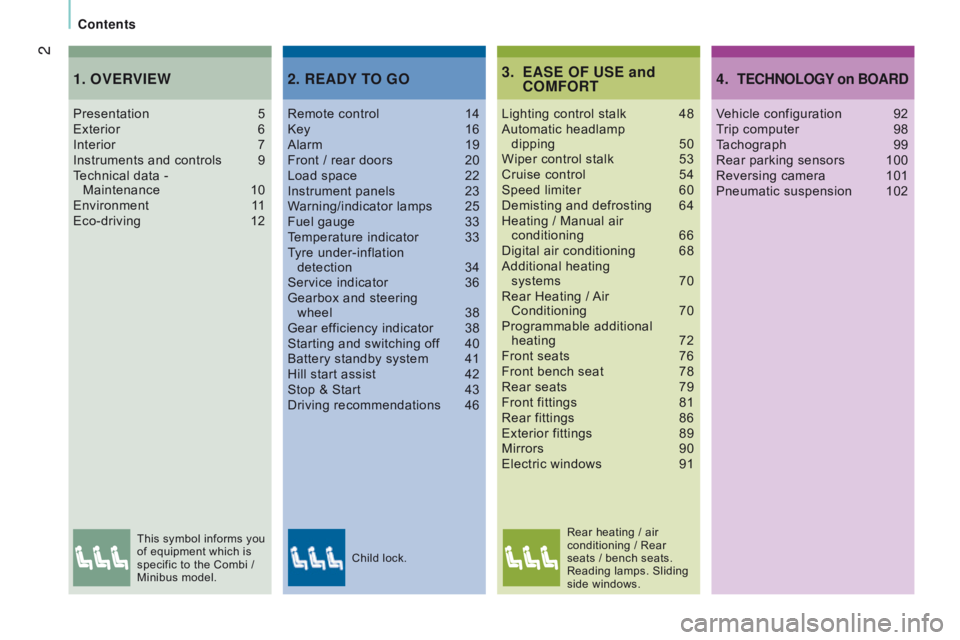
2
contents
3. EASE OF u SE and c
OMFO rt
Lighting control stalk 48
Automatic headlamp
dipping
50
Wiper control stalk
53
Cruise control
54
Speed limiter
60
Demisting and defrosting
64
Heating / Manual air
conditioning
66
Digital air conditioning
68
Additional heating
systems
70
Rear Heating /
Air
Conditioning
70
Programmable additional
heating
72
Front seats
76
Front bench seat
78
Rear seats
79
Front fittings
81
Rear fittings
86
Exterior fittings
89
Mirrors
90
Electric windows
91
Presentation
5
Exterior
6
Interior
7
Instruments and controls
9
T
echnical data -
Maintenance
10
Environment
1
1
Eco-driving
12
1. OVErVIEW 4. tEcHnOLOGY on BOArd
Vehicle configuration 92
T rip computer 98
T
achograph
99
Rear parking sensors
100
Reversing camera
101
Pneumatic suspension
102
2. rEAdY tO GO
Remote control 14
Key 16
Alarm
19
Front
/ rear doors
20
Load space
22
Instrument panels
23
W
arning/indicator lamps
25
Fuel gauge
33
T
emperature indicator
33
T
yre under-inflation
detection
34
Service indicator
36
Gearbox and steering
wheel
38
Gear ef
ficiency indicator
38
Starting and switching of
f
40
Battery standby system
41
Hill start assist
42
Stop & Start
43
Driving recommendations
46
This symbol informs you
of equipment which is
specific to the Combi /
Minibus model. Child lock.Rear heating / air
conditioning / Rear
seats / bench seats.
Reading lamps. Sliding
side windows.
Page 5 of 292
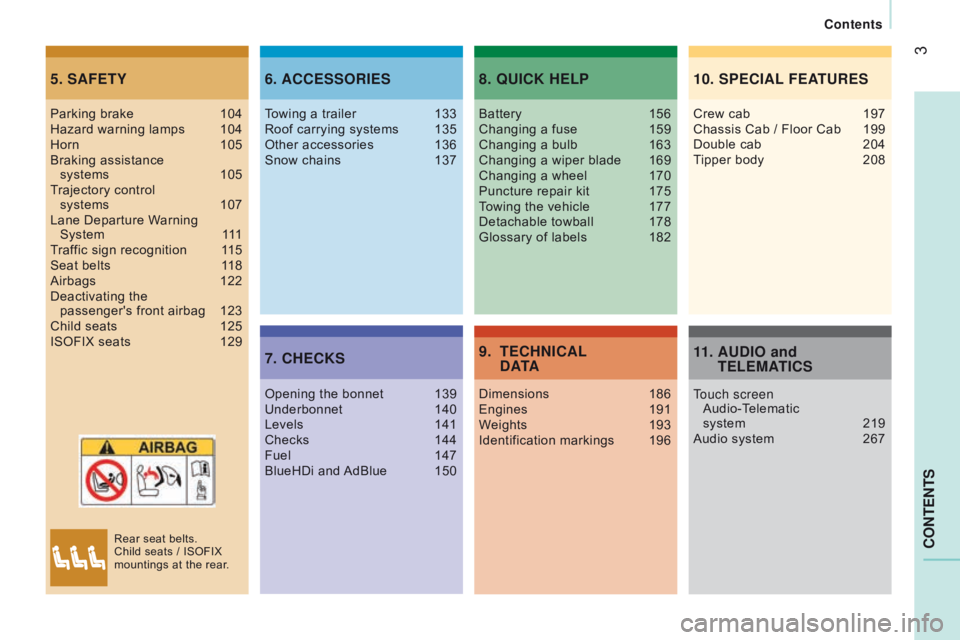
3
cOnt
Ent
S
5. SAFEtY6. A cc ESSO r IES
7. c HE c KS8. Q
u I c K HELP
9. t E c H n I c AL
dA
t A
Parking brake 104
Hazard warning lamps 104
Horn
105
Braking assistance
systems
105
T
rajectory control
systems
107
Lane Departure W
arning
System
1
11
Traffic sign recognition
1
15
Seat belts
1
18
Airbags
122
Deactivating the
passenger's
front airbag
123
Child seats
125
ISOFIX seats
129T
owing a trailer 133
Roof carrying systems
135
Other accessories
136
Snow chains
137
Opening the bonnet
139
Underbonnet
140
Levels
141
Checks
144
Fuel
147
BlueHDi and
AdBlue
150Battery
156
Changing a fuse
159
Changing a bulb
163
Changing a wiper blade
169
Changing a wheel
170
Puncture repair kit
175
T
owing the vehicle
177
Detachable towball
178
Glossary of labels
182
Dimensions
186
Engines
191
W
eights
193
Identification markings
196
11. A ud IO and t
ELEMAt I c S
10. SPE
c IAL FEA
tur
ES
Crew cab 197
Chassis Cab / Floor Cab 199
Double cab
204
T
ipper body
208
T
ouch screen
Audio-Telematic
system
219
Audio system
267
Rear seat belts.
Child seats / ISOFIX
mountings at the rear.
contents
Page 8 of 292
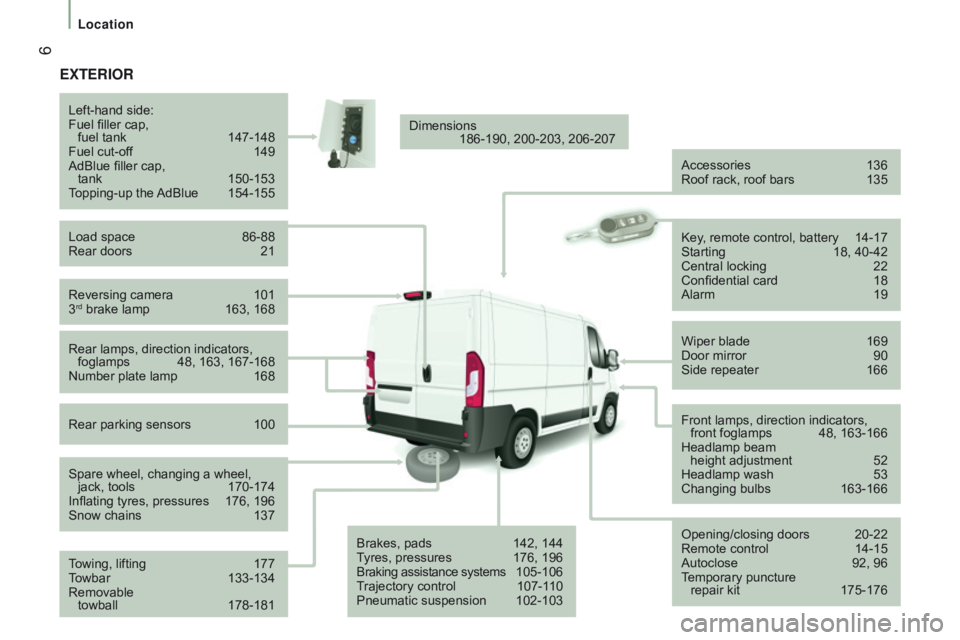
6
ExtErIOr
Reversing camera 101
3rd brake lamp 163, 168
Left-hand side:
Fuel filler cap,
fuel tank
147-148
Fuel cut-of
f
149
AdBlue filler cap,
tank
150-153
T
opping-up the AdBlue
154-155
Load space
86-88
Rear doors
21
Rear lamps, direction indicators, foglamps
48, 163, 167-168
Number plate lamp
168
Rear parking sensors
100
Spare wheel, changing a wheel, jack, tools
170-174
Inflating tyres, pressures
176, 196
Snow chains
137
T
owing, lifting
177
T
owbar
133-134
Removable
towball
178-181 Dimensions
186-190, 20
0-203, 206-207
Accessories
136
Roof rack, roof bars
135
Brakes, pads
142, 144
T
yres, pressures
176, 196
Braking assistance systems
1
05-106
Trajectory control
107-1
10
Pneumatic suspension
102-103Key
, remote control, battery
14-17
Starting
18, 40-42
Central locking
22
Confidential card
18
Alarm
19
Wiper blade
169
Door mirror
90
Side repeater
166
Opening/closing doors
20-22
Remote control
14-15
Autoclose
92, 96
T
emporary puncture
repair kit
175-176
Front lamps, direction indicators,
front foglamps
48, 163-166
Headlamp beam
height adjustment
52
Headlamp wash
53
Changing bulbs
163-166
Location
Page 14 of 292

12
EcO-drIVInG
Optimise the use of your gearbox
With a manual gearbox, move off gently
and change up without waiting. While
accelerating changing up early. If your
vehicle has the system, the gear efficiency
indicator invites you to engage the most
suitable gear; follow its instructions as
soon as it is displayed in the instrument
panel.
drive smoothly
Maintain a safe distance between vehicles,
use engine braking rather than the
brake pedal, and press the accelerator
progressively. These practices contribute
towards a reduction in fuel consumption
and CO
2 emissions and also helps reduce
the background traffic noise.
If your vehicle has cruise control, make
use of the system at speeds above 20 mph
(30 km/h) when the traffic is flowing well.
control the use of your electrical
equipment
Before moving off, if the passenger
compartment is too warm, ventilate it by
opening the windows and air vents before
using the air conditioning.
Above 30 mph (50 km/h), close the
windows and leave the air vents open.
Remember to make use of equipment
that can help keep the temperature in the
passenger compartment down. Switch off the headlamps and front
foglamps when they are not needed for
safety.
Eco-driving is a range of everyday
practices that allow the motorist to optimise
their fuel consumption and CO
2 emissions.
Avoid running the engine before moving
off, particularly in winter; your vehicle will
warm up much faster while driving.
Disconnect your portable devices before
leaving the vehicle.Switch off the air conditioning, unless it
has automatic digital regulation, as soon
as the desired temperature is attained.
Switch off the demisting and defrosting
controls, if not automatic.
Switch off the heated seat as soon as
possible.
Motoring & the Environment
Page 15 of 292
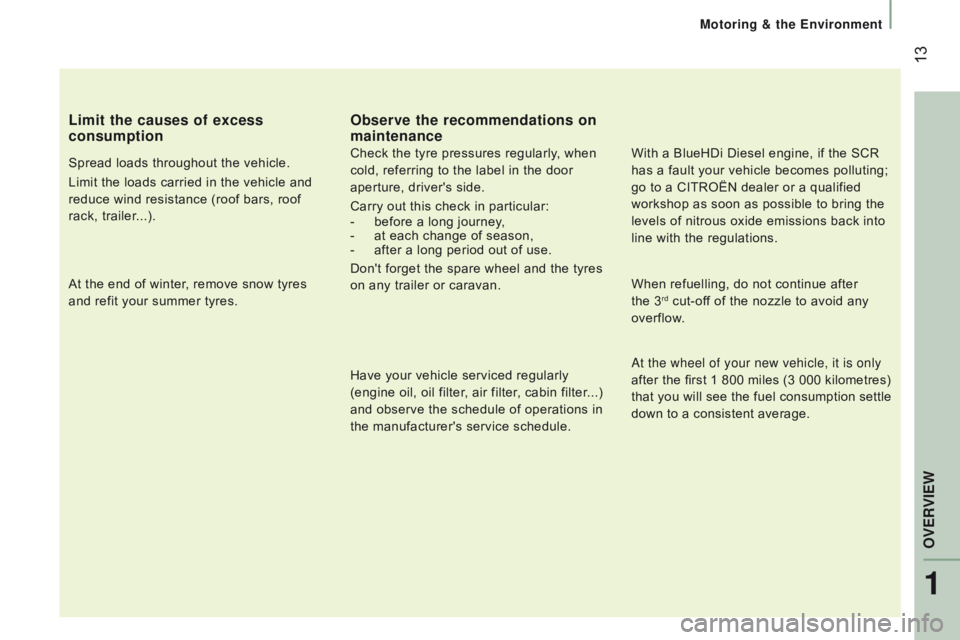
13
Limit the causes of excess
consumption
Spread loads throughout the vehicle.
Limit the loads carried in the vehicle and
reduce wind resistance (roof bars, roof
rack, trailer...).
At the end of winter, remove snow tyres
and refit your summer tyres.
Observe the recommendations on
maintenance
Check the tyre pressures regularly, when
cold, referring to the label in the door
aperture, driver's side.
Carry out this check in particular:
-
before a long journey
,
-
at each change of season,
-
after a long period out of use.
Don't forget the spare wheel and the tyres
on any trailer or caravan.
Have your vehicle serviced regularly
(engine oil, oil filter, air filter, cabin filter...)
and observe the schedule of operations in
the manufacturer's service schedule. With a BlueHDi Diesel engine, if the SCR
has a fault your vehicle becomes polluting;
go to a CITROËN dealer or a qualified
workshop as soon as possible to bring the
levels of nitrous oxide emissions back into
line with the regulations.
When refuelling, do not continue after
the 3
rd cut-off of the nozzle to avoid any
overflow.
At the wheel of your new vehicle, it is only
after the first 1 800 miles (3 000 kilometres)
that you will see the fuel consumption settle
down to a consistent average.
1
OVErVIEW
Motoring & the Environment
Page 18 of 292

16
KEY
This locks and unlocks the vehicle's doors,
opens and closes the fuel filler cap, as well
as starting and stopping the engine.
rEMOtE cOntrOL BAtt E rY
Reference: CR 2032/3 volts.
changing the battery
- Press the button to eject the key .
-
T
urn the screw 1 from the closed
padlock to the open padlock using a
screwdriver with a thin lip.
-
Use the screwdriver as a lever to extract
the battery holder housing 2 .-
Remove the housing and change the
battery 3 observing the polarities.
-
Put the battery holder housing
2
back
inside the key and secure it by turning
the screw 1 .
There is a risk of damage if the
replacement battery is not of the
correct type.
Only use batteries which are identical or of
an equivalent type to those recommended
by a CITROËN dealer. Take used batteries
to an authorised collection point.
Access
Page 25 of 292
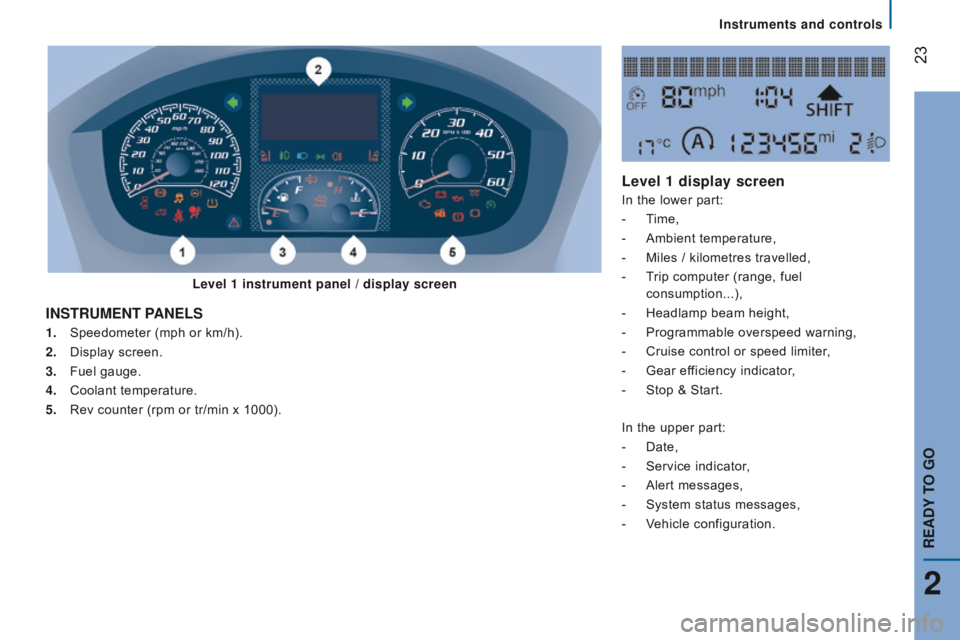
23
1. Speedometer (mph or km/h).
2.
Display screen.
3.
Fuel gauge.
4.
Coolant temperature.
5.
Rev counter (rpm or tr/min x 1000).
InStruMEnt PAnELS
Level 1 display screen
In the lower part:
-
T
ime,
-
Ambient temperature,
-
Miles
/ kilometres travelled,
-
T
rip computer (range, fuel
consumption...),
-
Headlamp beam height,
-
Programmable overspeed warning,
-
Cruise control or speed limiter
,
-
Gear ef
ficiency indicator,
-
Stop & Start.
In the upper part:
-
Date,
-
Service indicator
,
-
Alert messages,
-
System status messages,
-
V
ehicle configuration.
Level 1 instrument panel
/ display screen
2
rEAdY tO GO
Instruments and controls
Page 26 of 292

24
Level 2 display screen
In the left-hand part:
-
T
ime,
-
Ambient temperature,
-
Alert or state indicators,
-
Cruise control or speed limiter
.
In the right-hand part:
-
Date,
-
Service indicator
,
-
T
rip computer (range, fuel
consumption...),
-
Alert messages,
-
Messages on the state of systems,
-
V
ehicle configuration,
-
Headlamp beam height,
-
Miles
/ kilometres travelled.
Level 2 instrument panel
/ display screen
Instruments and controls
Page 31 of 292
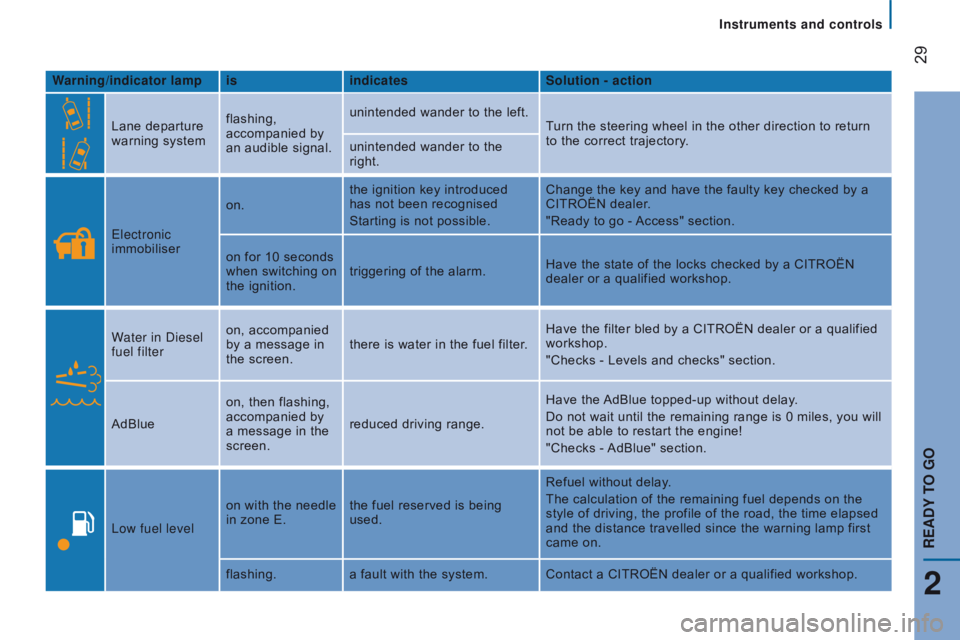
29
Warning/indicator lampisindicates Solution - action
Lane departure
warning system flashing,
accompanied by
an audible signal. unintended wander to the left.
Turn the steering wheel in the other direction to return
to the correct trajectory.
unintended wander to the
right.
Electronic
immobiliser on.
the ignition key introduced
has not been recognised
Starting is not possible. Change the key and have the faulty key checked by a
CITROËN dealer.
"Ready to go - Access" section.
on for 10 seconds
when switching on
the ignition. triggering of the alarm.
Have the state of the locks checked by a CITROËN
dealer or a qualified workshop.
Water in Diesel
fuel filter on, accompanied
by a message in
the screen.
there is water in the fuel filter. Have the filter bled by a CITROËN dealer or a qualified
workshop.
"Checks - Levels and checks" section.
AdBlue on, then flashing,
accompanied by
a message in the
screen. reduced driving range. Have the AdBlue topped-up without delay.
Do not wait until the remaining range is 0 miles, you will
not be able to restart the engine!
"Checks - AdBlue" section.
Low fuel level on with the needle
in zone E.
the fuel reserved is being
used. Refuel without delay.
The calculation of the remaining fuel depends on the
style of driving, the profile of the road, the time elapsed
and the distance travelled since the warning lamp first
came on.
flashing. a fault with the system. Contact a CITROËN dealer or a qualified workshop.
2
rEAdY tO GO
Instruments and controls
Page 35 of 292
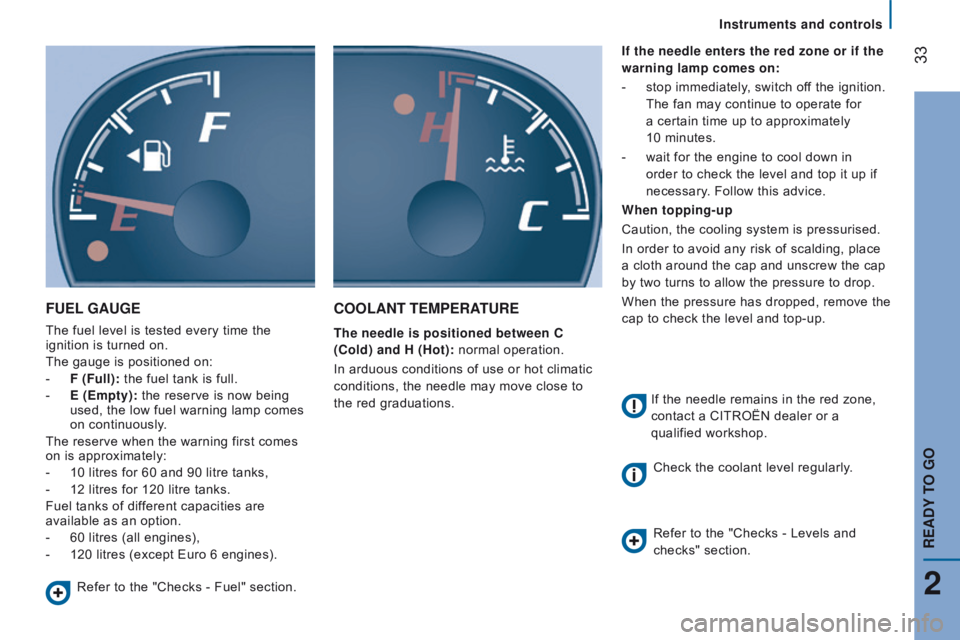
33
FuEL GA u GE
The fuel level is tested every time the
ignition is turned on.
The gauge is positioned on:
-
F (Full):
the fuel tank is full.
-
E (Empty):
the reserve is now being
used, the low fuel warning lamp comes
on continuously.
The reserve when the warning first comes
on is approximately:
-
10 litres for 60 and 90 litre tanks,
-
12 litres for 120 litre tanks.
Fuel tanks of dif
ferent capacities are
available as an option.
-
60 litres (all engines),
-
120 litres (except Euro 6 engines).
cOOLAnt tEMPErAtur E
the needle is positioned between c
( c old) and H (Hot): normal operation.
In arduous conditions of use or hot climatic
conditions, the needle may move close to
the red graduations. If the needle enters the red zone or if the
warning lamp comes on:
-
stop immediately
, switch off the ignition.
The fan may continue to operate for
a certain time up to approximately
10 minutes.
-
wait for the engine to cool down in
order to check the level and top it up if
necessary. Follow this advice.
When topping-up
Caution, the cooling system is pressurised.
In order to avoid any risk of scalding, place
a cloth around the cap and unscrew the cap
by two turns to allow the pressure to drop.
When the pressure has dropped, remove the
cap to check the level and top-up.
Refer to the "Checks - Fuel" section. If the needle remains in the red zone,
contact a CITROËN dealer or a
qualified workshop.
Check the coolant level regularly.
Refer to the "Checks - Levels and
checks" section.
2
rEAdY tO GO
Instruments and controls